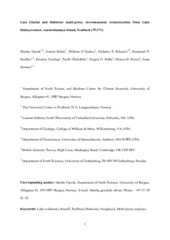Holocene multi-proxy environmental reconstruction from lake Hakluytvatnet, Amsterdamøya Island, Svalbard (79.5°N)
Gjerde, Marthe; Bakke, Jostein; D'Andrea, William J.; Balascio, Nicholas L.; Bradley, Raymond S.; Vasskog, Kristian; Ólafsdóttir, Sædis; Torgeir Opeland, Røthe; Perren, Bianka B.; Hormes, Anne
Journal article
Submitted version

Åpne
Permanent lenke
https://hdl.handle.net/1956/17808Utgivelsesdato
2018-03Metadata
Vis full innførselSamlinger
- Department of Earth Science [1050]
Originalversjon
https://doi.org/10.1016/j.quascirev.2017.02.017Sammendrag
High resolution proxy records of past climate are sparse in the Arctic due to low organic production that restricts the use of radiocarbon dating and challenging logistics that make data collection difficult. Here, we present a new lake record from lake Hakluytvatnet at Amsterdamøya island (79.5°N), the northwesternmost island on Svalbard. Multi-proxy analyses of lake sediments in combination with geomorphological mapping reveal large environmental shifts that have taken place at Amsterdamøya during the Holocene. A robust chronology has been established for the lake sediment core through 28 AMS radiocarbon ages, and this gives an exceptionally well-constrained age control for a lake at this latitude. The Holocene was a period with large changes in the Hakluytvatnet catchment, and the onset of the Neoglacial (ca. 5 ka) marks the start of modern-day conditions in the catchment. The Neoglacial is characterized by fluctuations in the minerogenic input to the lake as well as internal productivity, and we suggest that these fluctuations are driven by atmospherically forced precipitation changes as well as sea ice extent modulating the amount of moisture that can reach Hakluytvatnet.